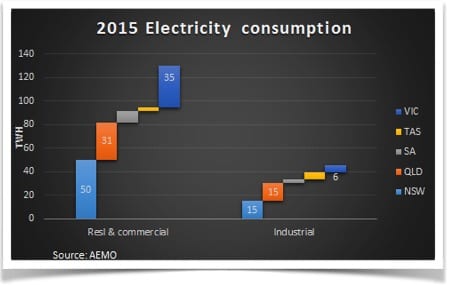Spot electricity prices last week were dramatically higher than at the same time last year, although volatility was somewhat reduced. The increase in prices is despite consumption over the past 30 days been less than the previous corresponding period (PCP) in all States other than Queensland. Consumption remains up on PCP for the calendar year to date [CYTD].
Baseload futures prices have continued to edge up on minimal volumes. This illustrates the point that spot prices generally feed into futures prices and both spot and future prices feed into final consumer prices.
Volatility remains high in the spot market with negative prices seen during the week in South Australia and Victoria. Retailers need to protect against volatility. They typically do this through a mixture of caps, swaps, and by owning or contracting some peak (hydro or open cycle gas) generation. In the end though this all has to be paid for so higher volatility once again increases costs to consumers, and encourages consumers to explore self generation (rootop PV) and volatility reducers (household and business storage).
The basic message of the high spot and futures prices, confirmed by the ongoing high prices in the REC market (albeit fractionally down on last week) is that there is a need for new generation and new renewable generation likely offers the highest returns. Price signals work and they will work in this case sooner or later.



This week we include a table of listed utility share prices, also showing market capitalisation and looking at the share price movements over various time periods. What a fascinating table it is.
As always with share prices it mostly depends on your starting point. APA has been an outstanding investment for several years, the pick of the utilities. Over the past 12 months AGL’s performance has been outstanding considering its Australia’s largest carbon emitter, has written off large sums related to gas exploration and profit permanence has been no better than OK. Redflow [RFX] and Infigen [IFN] have done well this year. RFX is entirely speculative. Over the past week yield related stocks did well.
A quick look at the overall consumption figures as presented by the AEMO is shown below. The AEMO probably classifies some consumption in the commercial sector that most of us would think of as industrial. Even so the chart makes it very clear that residential and commercial consumption in NSW is by far the most important value driver in the entire NEM. That’s why the legal decisions regarding network pricing are so important to all stake holders. Its also why full retail deregulation from July 1 this year is a bigger deal than it might seem on the surface.
Digging into NSW a bit further we had a look at the annual Ausgrid consumption by postcode data.
The chart below contains some mixed data but the point is that non residential consumption both large and small was still declining in FY15 but residential consumption per household had started to grow again as a result probably of abolition of the carbon tax and other factors that have removed the price sticker shock from household minds. Data for both charts below is from Ausgrid. The data in the last charts basically shows that the physical size of the house is the main driver of consumption per house.



David Leitch was a Utility Analyst for leading investment banks over the past 30 years. The views expressed are his own. Please note our new section, Energy Markets, which will include analysis from Leitch on the energy markets and broader energy issues. And also note our live generation widget, and the APVI solar contribution.










